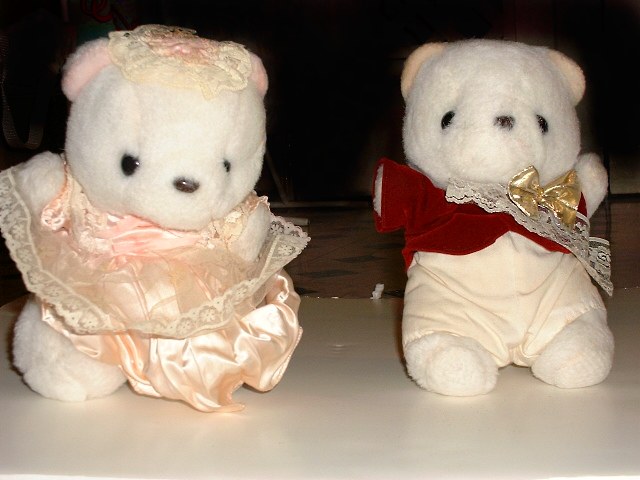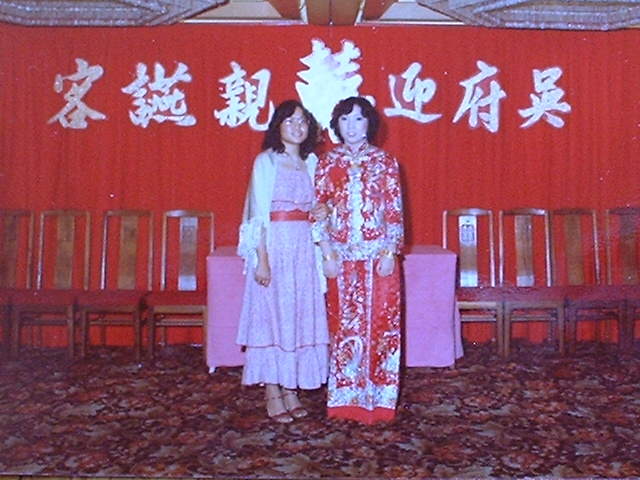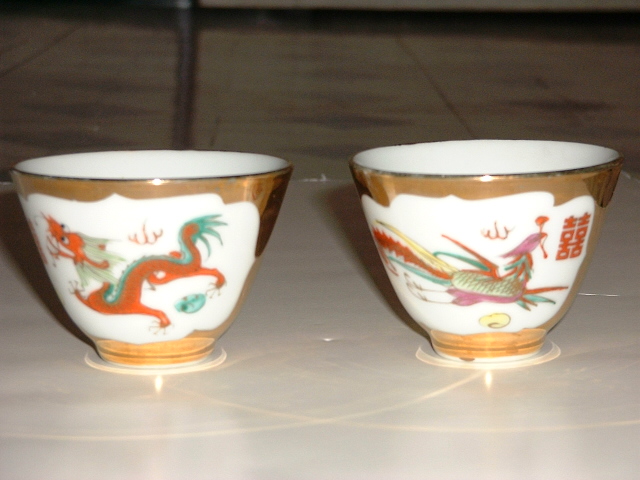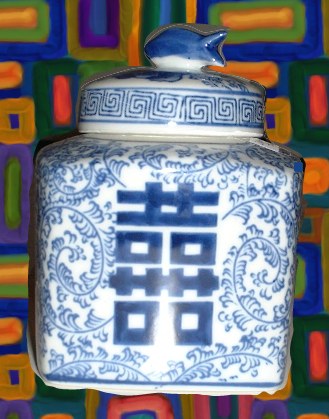
Introduction
A Hong Kong wedding is fun to watch, great to taste, enough to fill your stomach, but expensive to participate in. During the period 1960-1980s, Hong Kong people were very westernized. Among educated groups, most believed in freedom of marriage. However, arranged marriages were also popular. It was very common for engaged couples to have a great glamourous wedding to celebrate their very first time, to show off their wealth and to please the bride's parents. To get the engagement, the grooms had to ask the bride's father or guardian for acceptance of marriage. If the answer was yes, the groom started to prepare for the engagement ceremony. The financial burden began.
ENGAGEMENT 
Months before the engagement rite, the grooms would receive a dowry list (![]() saam shue lük lai), which was written by the bride's father. Usaually, the groom's parent approved it if it was reasonable and affordable. However, some engaged parties just turned out to be enemies and barked at each other. Of course, their children's wedding was out of question.
saam shue lük lai), which was written by the bride's father. Usaually, the groom's parent approved it if it was reasonable and affordable. However, some engaged parties just turned out to be enemies and barked at each other. Of course, their children's wedding was out of question.
If the list was good enough to proceed, the groom started to purchase and gather according to the demands on the list. On the engagement day, the groom's side would send a troop of bachelors and old maids to the bride's side, shipping goodies such as :
- gold items
- silver items
- Hong Kong currency
- stocks
- wedding cakes
FOOD
Wedding Cakes:
Chinese wedding cakes are great and rare, a baked crispy pastry. Outside layers are made of thin colorful flaky flour sheet (like Greek filo) and inside fillings of either:
- lotus seed paste
- red bean paste
- green bean paste
- assorted fruit
- winter melon strips and sesame seeds
Besides the wedding cakes, the bride would keep all the jewelry, and her parents would keep the antiques and money. Although it is often heard like, "we are not selling our daughters, but we are only marrying them off", a popular phrase always given by her parents. Right?!
Those tons of wedding cakes came in nice round lacquer wooden boxes, and would be distributed among the brides's relatives together within an invitation card. This card was officially printed in gold at the print shop, and red in color. Sometimes, the modern Hong Kong brides would send their invitation cards attached with a little cake coupon by which they could redeem for a dozen of western pastries free. I like both kinds.
For the bride, she started to prepare some items for her wedding room. It was still common to live with in-laws. Therefore, she did not need to worry about anything except her :
- jewelry for the rainy days;
- blankets embroidered in phoenix and dragon symbols;
- new wedding gowns (a western white gown and a chinese golden and red cheung saam
 );
); - new dinner and tea sets

WEDDING DAY 
The bride usually did not get enough rest before their big day. She would be anxious about whether she would perform correctly at the wedding. When the sun rose, the bride's mom got up early to prepare wine, make sacrifices for the ritual ceremony to the ancestors, and prayed for her daughter's happiness. She lit scented incense and long stick candles in the urn. The house was covered with fragrance.
The bride had her western wedding gowns on with a veil. She would rent her white gown and return it after the wedding was over. A group of bride maids and maid-of-honor would stay with her and waited for the gentleman's call.
The door bell rang, the bridesmaids would not open the door immediately. Instead, they put a chain on and opened it ajar. A bargain began. This was a fun game. Outside the door, a group of bridegrooms managed the trade. They called out the bid and the bargain went on back and forth. Sometimes it would last for half an hour or so if both sides agreed generally and reasonably.
Then the tip would be handed over, in a red pocket, to the maid of honor. The door now opened, the bridegrooms busted in. The bride's parents greeted them and fed them tea and goodies like:
 t'öng lďn tsz - sweetened lotus seeds
t'öng lďn tsz - sweetened lotus seeds kwa tsz - watermelon seeds
kwa tsz - watermelon seeds haäm naän kwa tsz - salted pumpkin seeds
haäm naän kwa tsz - salted pumpkin seeds t'öng oô t'aü - sweetened taro root slices
t'öng oô t'aü - sweetened taro root slices t'öng lďn ngau - sweetened lotus root slices
t'öng lďn ngau - sweetened lotus root slices t'öng yë sz - sweetened coconut strips
t'öng yë sz - sweetened coconut strips t'öng tung kwa - sweetened wintermelon strips
t'öng tung kwa - sweetened wintermelon strips- swiss chocolate

The bride's father held the bride's hand and walked her out and officially handed her to the groom. The ceremony began in the bride's house. The couple kneeled down and presented each of the bride's parents who was sitting in front of them a cup of tea with lotus seed in it. Then, the bride's parents would give the bride a pair ok 24 caret solid gold bangels. Some of them were shaped like the dragon and phoenix. A pearl necklace set, or a gold chain with a silk plaque scarved with some good wishes like 'luck' (![]() ) or happiness (
) or happiness (![]() ) or wedding (
) or wedding (![]() ). Interestingly, the bridal car was gaudily decorated. A set of wedding plastic dolls were put in the middle of the front hood and tied down by plain white silk ribbons. Some were decorated with real flower petals or silk flowers above the whole car. It was well dressed for the bride. Usually, they rented a nice limousine, a Mercedes-Benz or BMW.
). Interestingly, the bridal car was gaudily decorated. A set of wedding plastic dolls were put in the middle of the front hood and tied down by plain white silk ribbons. Some were decorated with real flower petals or silk flowers above the whole car. It was well dressed for the bride. Usually, they rented a nice limousine, a Mercedes-Benz or BMW.
This car transported the bridal party to the Hong Kong city hall where their legal ceremony took place. Surprisingly, some of them could get married at the church, even if they were not Christian.
These were the popular westernized ceremonies for a Hong Kong wedding. The most popular church for weddings was the one on Caine Rd., the Roman Catholic Cathedral .
Besides, it was very common for a bride and a groom to have their perfect wedding pictures at a studio. They preferred to have a perfect studio image hung on the wall instead of some imperfect real figures made by a amateur photographer during the wedding itself.
After the portraits were taken, the groom possessed his bride and he took her home. At his home, his parents and relatives would sit up and wait for their new member to come, to present a cup of tea for her recognition. Before the bride walked on the premises, an old match-maker or an old maid, would sprinkle some uncooked raw rice on her head and some rose petals. Some traditional families would even make her jump across a urn of burning golden papers. Usually, the bride would go inside her wedding room. She changed her ' west' to 'east' look and came out with a golden embroderied dress with red background top and a red skirt. She would wear a pair of high-heeled red shoes or a pair of traditional red cloth embroderied kung-Fu shoes. She carried a red silk handerchief in her hand. A beautiful full-bloom seasonal flower would be pinned on her top close to her bosum. Her hair would be bundled up in a bun with a lot of gold pin, and hair accessories. It was quite common to rent a chinese wedding gown for both brides and grooms, (see picture), but I have never been to a wedding at which the groom had dressed in chinese costume. They thought those were uneconomical and not modernized. Poor man! They have to change to satisfy his bride and her family. No more excess money for himself to show. The groom wore a suit for a whole day. However, the bride commonly changed three times or wore 3 sets of clothes for her wedding day.
CEREMONY FOR GROOM'S FAMILY
The bride was traditionally classified as a possession of the groom. Therefore, when she was brought home, she needed to show respect to his family by presenting tea. Another tea ceremony. Both parents would sit in high "power" chairs in the front parlor. The bride and the groom walked to them and knelt down and bowed three times. An old maid handed the bride and the groom cups of tea and they had to present to the parents. The mother-in-law would make a lovely wish, if fortunately, to her and gave her some jewelry like golden bangles, a watch, some earrings, rings, some treasures. She got from her in-law and belonged to the family and etc. Of course, an old maid would serve them all some lotus seeds
(![]() ) which wished them to have a son in the future.
) which wished them to have a son in the future.
THE BANQUET
Around five o'clock, the couples and both families should have shown up at the restaurant. The lobby of the restaurant was decorated with a big wedding sign and below it, they listed out the family names of both sides like this:
X Y
The relatives started to arrive and gave them a red pocket with cash or some gold jewelry to the brides. The most popular entertainment was mahjong. Very soon, the whole floor was covered with mahjong knick-knock sound, curses, laughs, children's screams, and crying voices of the bride's relatives.
The most common food served at this time was uük sz mîn (![]() ) - pork strings noodle soup. About eight o'clock, the banquet began. It was traditionally at least nine courses, not 7 or 10. Seven was used for mourning weeks. Ten was not even lucky. After a course of shark-fin soup, the bride excused herself and went to change her traditional gown to a modern outfit, which would show her figure and appeared very westernized. Then the couples would have a glass of liquor, followed by the best man who carried a bottle of VO brandy, or Johnny Walker. The maid of honor would join him, and the married couple would go to each table to thank the attendants, and receive a small toast. Those playful friends and relatives, however, would keep the toasts going at each table, cruelly making the groom and the bride drunk. They made them to do games like :
) - pork strings noodle soup. About eight o'clock, the banquet began. It was traditionally at least nine courses, not 7 or 10. Seven was used for mourning weeks. Ten was not even lucky. After a course of shark-fin soup, the bride excused herself and went to change her traditional gown to a modern outfit, which would show her figure and appeared very westernized. Then the couples would have a glass of liquor, followed by the best man who carried a bottle of VO brandy, or Johnny Walker. The maid of honor would join him, and the married couple would go to each table to thank the attendants, and receive a small toast. Those playful friends and relatives, however, would keep the toasts going at each table, cruelly making the groom and the bride drunk. They made them to do games like :
- try to eat an apple with their mouth, but hands free
- kisses
- rock-paper-scissors
After a good meal and a tiresome day, the bride was exhausted. Traditionally, the bride was kept in her room and ate with her half-way drunk husband after he finished his social duties outside. The latter was better for the bride physically. Hong Kong people combined two cultures 'East and West' together at their wedding, and made the brides tired earlier.
The next day, the bride was trained to take her in-law role, and set up her very first ceremony to the ancestors of her husband family. In the afternoon she would go back to her parents' home for a short visit and had a dinner there. It should be the third day event, but the people of Hong Kong liked to make it simple and matched with their leaves from work.
COMMENT:
Can people throw away this expensive and unaffordable wedding tradition show? It hurts and is meaningless. People in Hong Kong still practice this wedding show time - a glamorous reception of 50 tables at 12 per table, with a banquet of 9 courses of food. A poor groom grieves for his financial debt after the wedding. This burden on the groom was traditionally set to pay back the bride's parent for raising his bride, the property of the groom. However, today, the men of Hong Kong generally lack the stimulation to get married earlier than 30 because of the burden of saving for this wedding reception, honeymoon, and future home, as well as a a nice sum to the bride's family. It sounds fair and beautiful to have a big wedding, but what do you think about his years of savings being used up in just one day on :
- a grand banquet of 9 courses
- a party of 50 tables at least;
- a show time for the bride.
In some families, the in-laws insist on following ritual and traditional customs. They make the bride to kneel in front of the one who is younger than her, but have a higher or same level at the family tree. She has no feeling and no heart on this matter, but she believes she ought to follow just for show and obtain a compliment from the audience that she is well prepared by her family.
Another attackable practice in the oriental wedding is a burden on those whom are invited. Nowadays, the market price for a red pocket cash is US$50 for each attendant about HK$500 per person. It is very popular in America among those Vietnamese, mainland Chinese,and Taiwanese communities. For those closest relatives and family, they need to give the bride real gold items like 24k or 22k. Buying expensive gold and giving it to the bride who will be my cousin's wife, I feel overdoes it, unless she is my dear friend. Normally, she is the character of a stranger to the male family.
This kind of showing of wealth behavior should have been reformed and eliminated by the revolution. However, it exists and elaborates well in Oriental-American societies. Those traditional rites could survive if the parties involved could enjoy some happiness and peace from them. To a Catholic, marriage is a unity of two people and is a sacrament and celebration for their new beginning."Love and Happiness do not need money to prove."

© 2019-2024 Kevin & Connie Lacobie Some graphics by: www.Vecteezy.com
